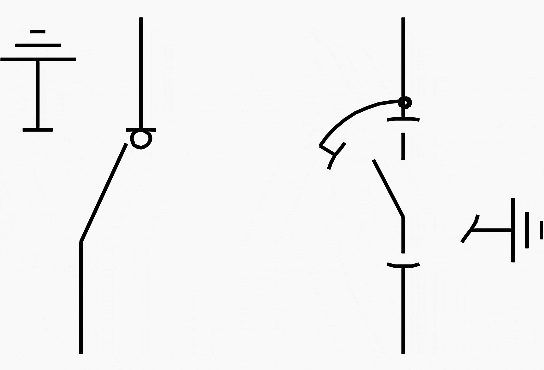Isolation and earthing
Medium voltage switches for use on 1-52kV indoor systems are predominantly used for isolation and earthing. Although the majority of these switches are air insulated, gas insulated (SF6) combination switches are available, which are designed for load and fault current switching.

Operation of a switch can be manual or motorized. International standards provide maximum torque levels required to operate manual disconnect and earth switches.
There must be a visual indication of the switch position (by viewing the contacts or an indicator driven directly from the contacts).
Contents:
1. Medium voltage switches
1.1 Disconnector (fixed or withdrawable)
Main function: Isolation
Description:
- Rated for carrying continuous load current with a short-time withstand fault current rating (Ik)
- No continuous overload capability
- No switching capability
- Used with a circuit breaker or contactor and fuse combination
Symbol:


1.2 Switch-Disconnector (load-break isolator)
Main function: Switching and isolation
Description:
- Rated for carrying continuous load current with a short-time withstand fault current rating (Ik)
- Can switch rated current (Ir) but has no fault make capability
- Used with line fuses or a circuit breaker
Symbol:


1.3 Earth switch
Main function: Earthing
Description:
- Rated for carrying continuous load current with a short-time withstand fault current rating (Ik)
- No load switching capability, but can make on a fault (Ip)
- Used with a circuit breaker or contactor and fuse combination
Symbol:


1.4 Gas insulated Earth-disconnector (fixed or rotary)
Main function: Switching, isolation and earthing
Description:
- Rated for carrying continuous load current with a short-time withstand fault current rating (Ik)
- Can switch rated load current (Ir)
- Can make on fault current (Ip)
- Used with line fuses or a circuit breaker
Symbol:


2. Applications
A typical medium voltage metal-enclosed switchgear feeder circuit will have a combination of switchgear able to provide the following functions:
- Switching of load current
- Short circuit protection
- Means of isolation
- Means of earthing
2.1 Withdrawable circuit breaker
Description:
- The withdrawable circuit breaker provides load switching, short circuit protection and circuit isolation when opened and in the draw-out position.
- The cable-side earth switch is interlocked with the circuit breaker and can only be closed when the circuit breaker is in the drawn-out position.
- A protection device is required to provide overload and short circuit protection
Scheme:


2.2 Withdrawable contactor
Description:
- The withdrawable contactor with integrated fuses provides load switching and circuit isolation when opened and in the draw-out position. The fuses provide short circuit protection.
- The cable-side earth switch is interlocked with the contactor and can only be closed when the contactor is in the drawn-out position.
Scheme:


2.3 Gas insulated rotary disconnector
Description:
- The gas insulated rotary disconnector has three physical operating positions. It provides load switching in the ON position, isolation in the OFF position and earthing in the EARTH position.
- Short circuit protection is provided by fuses, but a fixed type circuit breaker could be used instead.
Scheme:


3. IEC Ratings for disconnectors and earth switches
Disconnectors and earth switches are type tested to specific IEC standards. IEC 62271-1 provides standard ratings and IEC 62271-102 details test methods and specific requirements for medium voltage disconnectors and earth switches.
The nameplate label must show the manufacturer’s name, equipment model and serial number, and certain rating information. Many manufacturers also provide additional rating information.


3.1 Rated voltage, Ur (kV)
Maximum operating voltage (rms) the device can continuously withstand during normal operation. The rated voltage must be greater than or equal to the system’s operating voltage.
Standard values for Ur: 3.6, 7.2, 12, 17.5, 24, 36 kV (source: IEC 62271-1)
Max. value for Ur: MV switches tend to have a maximum Ur of 36 kV.
3.2 Rated lightning impulse withstand rating, Up (kV)
This is the peak voltage the device can withstand for a 1.2/50 µs standard test wave. Standard values for Up:
| Ur (kV) | 3.6 | 7.2 | 12 | 17.5 | 24 | 36 |
| Up (kV) | 40 | 60 | 75 | 95 | 125 | 170 |
(source: IEC 62271-1)
3.3 Rated frequency, fr (Hz)
This rating must match the system’s operating frequency. Rated frequency only has to be marked on the device nameplate if it is not suitable for 50 Hz and 60 Hz operation.
3.4 Rated current, Ir (A)
This is the rms level of current which can continuously flow through a device without exceeding its maximum allowable contact temperature rise.
Standard values for Ir: 630, 800, 1000, 1250, 1600, 2000, 2500, 3150, 4000 A
Max. value for Ir: MV switches tend to have a maximum Ir of 2500 A.
3.5 Rated short-time withstand current, Ik (kA)
This is the maximum rms symmetrical fault current the device can withstand, for a short time period, without risk of damage. This rating must be higher than the prospective rms fault current at the point of installation.
Ik ≥ Is
Is = SSC / √3×U
Where:
- Ik = short-time withstand current rating (kA)
- Is = prospective rms fault current (kA)
- SSC = system short circuit power (kVA)
- U = system operating voltage (kV)
Standard values for Ik: 6.3, 8, 10, 12.5, 16, 20, 25, 31.5, 40, 50, 63 kA
Max. value for Ik: MV switches tend to have a maximum Ik of 31.5 A.
3.6 Rated short circuit duration, tk (s)
This is the time the device can endure its rated short-time withstand current (Ik) without damage. This value must be greater than the total expected clearing time of a fault at the point of installation.
Standard values for tk: 0.5, 1, 2, 3 seconds (source: IEC 62271-1)
Note: MV switches tend to have a tk rating of 1 second.
3.7 Rated peak withstand current (kA)
This is the maximum peak fault current level which the device is able to close (make) on. This rating must be greater than the expected peak let-through fault current (Ip) at the point of installation.
Rated peak withstand current ≥ Ip
- Ip = 2.5 × Is (for a 50 Hz supply with a 45 ms DC time constant)
- Ip = 2.6 × Is (for a 60 Hz supply with a 45 ms DC time constant)
Where:
- Ip = asymmetrical peak let-through fault current, from the first fault loop (kA)
- Is = rms symmetrical fault current level, with no DC component (kA)
Note: MV earth switches tend to have a maximum Ip of 82 kA.
3.8 Electrical endurance class
This class defines the fault making capability of earth switching devices.
- E0 (Standard electrical endurance): No fault making capability
- E1 (Extended electrical endurance): Capable of 2 fault making operations without damage
- E2 (Highest electrical endurance): Capable of 5 fault making operations without damage
3.9 Mechanical endurance class
This class defines the mechanical endurance of no-load disconnectors.
- M0 (Standard electrical endurance): 1,000 operating cycles without maintenance
- M1 (Extended electrical endurance): 2,000 operating cycles without maintenance
- M2 (Highest electrical endurance): 10,000 operating cycles without maintenance
4. Videos
4.1 MV air insulating switchgear (AIS)
4.2 Introduction to medium voltage components
Source: MV application guide for engineers to select and specify the right MV equipment – AuCom


request feedback for required operation for 69kV Disconnectors/earth switches should be local only or remote operation beneficial and mandatory if as per any standard. Please guide.
This did not cover induced current switching class. How is this applied to Earthing switches?
Good read, just to note rated current is now known as rated continuous current
is it recommended as per IEC to calculate the force on the earth switch before and after these test?
Do we need to provide earthing switch with each incomer VCB?? or providing earthing switches on each outgoing VCB will suffice????
Was good, Thank You
Thank You
Thanks. It was helpful.
excellent
Very educative material
Good article.
Very informative and helpful to refresh on various aspects. Thanks
Avery great article,good work.
Thank you Dominic.